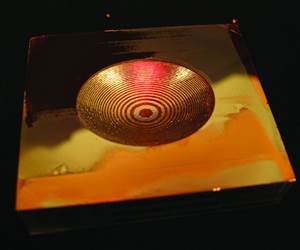3D Systems Develops C-103 Metal Alloy for Challenging Environments
This niobium alloy with hafnium and titanium alloying elements is resistant to decomposition by heat, pressure or chemical attack and thus retains its strength and form at high temperatures.
Share
Read Next
This niobium-alloy withstands high temperatures and stresses making it well-suited for propulsion applications in space, aerospace, and defense industry applications. Photo Credit: 3D Systems
3D Systems’ Certified C-103 is a metal material with incredible high-temperature strength as well as excellent resistance to vibrations at cryogenic temperatures to deliver parts with exceptional mechanical properties for challenging environments.
C-103 is a niobium alloy with hafnium and titanium alloying elements. It is classified as a refractory material, which is resistant to decomposition by heat, pressure or chemical attack and thus retains its strength and form at high temperatures.
The material has a high service temperature of between 1,200°C and 1,400°C and is capable of withstanding high stresses at those elevated temperatures. Because of its low ductile-to-brittle transition temperature, C-103 has excellent resistance to high-frequency vibrations, making it well suited for rocket, hypersonic and jet-propulsion applications, including spacecraft, satellites and launch vehicles in the space, aerospace and defense industries.
It is specifically designed for high-temperature and high-corrosive operating applications. Parts in C-103 can operate reliably up to a service temperature of approximately 1,480°C. For example, at a temperature of 1,093°C, C-103 has more than double the strength of Ni718 or Ni625.
Specifically, the material is well suited for high-temperature aerospace propulsion and satellite components such as steering nozzles, high-thrust nozzles, thrust chambers, turbine blades, jet engine afterburner flap sections and burst disks test stands components. Other applications include highly corrosive environments, such as chemical processing components.
3D Systems offers application development and part production using the integrated additive manufacturing (AM) workflow software, 3DXpert and the DMP Flex/Factory 350 metal 3D printers. The Certified C-103 parameters were developed, tested and optimized in cooperation with its AS9100/ISO9001 part production facilities, which have printed more than 1,000,000 challenging metal production parts in various materials, year over year.
C-103 was used for the first time in the Apollo-manned lunar module rocket engine in 1965. It has since been adopted for various ultrahigh-temperature applications, such as rocket nozzles, jet propulsion and thrust augmenter flaps. 3D Systems offers this standard alloy now as a solution for AM. The Certified C-103 (A) material is initially offered on the single-laser configurations and is currently compatible with the DMP Flex 350, DMP Flex 350 Dual and DMP Flex 350 Triple as well as the DMP Factory 350 and DMP Factory 350 Dual.
The extremely low oxygen environment of the DMP Flex and Factory 350 vacuum chamber architecture minimizes oxygen pickup, ensuring the best conductivity properties. In effect, the DMP Flex and Factory 350 Architecture enables indefinite storage of C-103 powder under low oxygen conditions. Moreover, with the DMP Factory 350 system, the entire powder handling cycle can be done under an inert environment.
Also, the 3D Systems build volume reducer accessory for the DMP Flex or Factory 350 DMP systems reduces the required amount of powder to load in the printer and allows for cost-efficient pilot application development and pilot production. For companies looking to develop new applications and processes with Certified C-103, 3D Systems’ Application Innovation Group can support and accelerate this development.
- Read about 3D Systems’ SLS 300 which enables advanced SLS technology in smaller manufacturing environments. A new Powder Recycling Station (PRS) is an optional accessory available in 2024 which works in tandem with the printer to automatically recycle unused powder currently in the system and mix it with fresh material.
- Learn about 3D Systems’ Accura AMX Resin which withstands harsh thermal environments. The resin material is well suited for the testing of high-temperature components in applications such as HVAC, consumer appliances, motor enclosures, fixtures, mounts, stators, molding/tooling and more.
Related Content
What is Powder Bed Fusion 3D Printing?
Whether in metal or polymer, with a laser or an electron beam, powder bed fusion (PBF) is one of the most widely used 3D printing techniques.
Read MoreAluminum Gets Its Own Additive Manufacturing Process
Alloy Enterprises’ selective diffusion bonding process is specifically designed for high throughput production of aluminum parts, enabling additive manufacturing to compete with casting.
Read MoreVulcanForms Is Forging a New Model for Large-Scale Production (and It's More Than 3D Printing)
The MIT spinout leverages proprietary high-power laser powder bed fusion alongside machining in the context of digitized, cost-effective and “maniacally focused” production.
Read MoreAM 101: What is Ultrasonic Additive Manufacturing?
Going from additive to subtractive can be simple with Ultrasonic Additive Manufacturing (UAM). What is it and how does it work? Learn the basics in this 101 post.
Read MoreRead Next
At General Atomics, Do Unmanned Aerial Systems Reveal the Future of Aircraft Manufacturing?
The maker of the Predator and SkyGuardian remote aircraft can implement additive manufacturing more rapidly and widely than the makers of other types of planes. The role of 3D printing in current and future UAS components hints at how far AM can go to save cost and time in aircraft production and design.
Read More4 Ways the Education and Training Challenge Is Different for Additive Manufacturing
The advance of additive manufacturing means we need more professionals educated in AM technology.
Read MoreHybrid Additive Manufacturing Machine Tools Continue to Make Gains (Includes Video)
The hybrid machine tool is an idea that continues to advance. Two important developments of recent years expand the possibilities for this platform.
Read More























